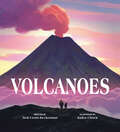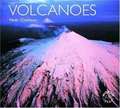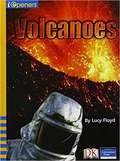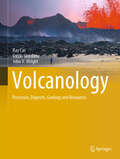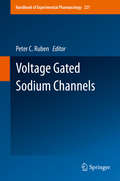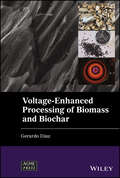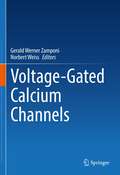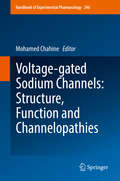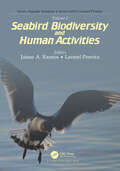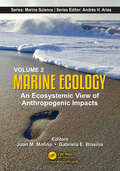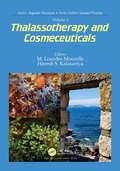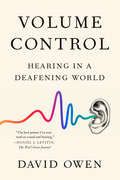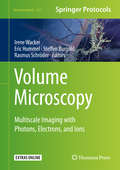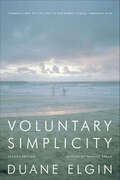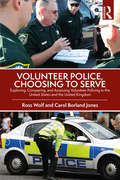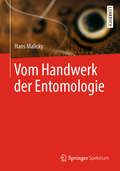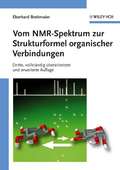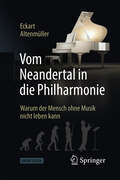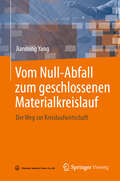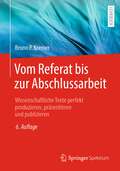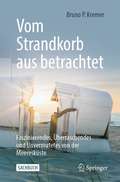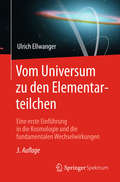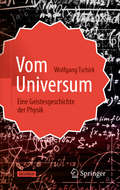- Table View
- List View
Volcanoes
by Nell Cross BeckermanThe team behind the acclaimed book Caves returns with an enticing exploration of one of the most explosive wonders on the planet--Volcanoes!A rumble. A tremble. A grumble. Growing, growling, getting hot. When will it...POP?!Using evocative storytelling, Nell Cross Beckerman leads children on an adventure through the radioactive wonders that are volcanoes. From deep down on the ocean floor to extraterrestrial volcanoes, Beckerman guides readers with dramatic, poetic language. Nonfiction text on every page allows for deeper understanding of the topic.Illustrator Kalen Chock's stunning illustrations have been praised as "atmospheric" and "striking," and readers will be delighted as each new page brings a new surprise. Extensive backmatter includes an author's note, additional information on the types of volcanic eruptions and the questions volcanologists are trying to answer, and additional facts. An ideal choice for nature lovers, future explorers, and fans of Jason Chin and Kate Messner.
Volcanoes (Worldlife Library)
by Peter ClarksonWhat are volcanoes? Where and why do they happen? The aim of this book is to answer these questions and to explain one of the great natural wonders of the Earth. Volcano! Just the mention of the word creates a mental picture, which varies with the listener's own perception. An artist may think of the classical shape of Mount Fuji; a historian may recall the destruction of Pompeii by Vesuvius; a geologist may speculate about the gas content of the lava in relation to its viscosity; a newspaper editor may see the scope for spectacular photographs and stories of human suffering and heroism that will boost newspaper circulation. Whatever thoughts spring to mind, nobody can be but impressed by the awful power of a volcanic eruption and the devastation that may be caused.
Volcanology: Processes, Deposits, Geology and Resources (Springer Textbooks in Earth Sciences, Geography and Environment)
by Ray Cas Guido Giordano John V. WrightThis book is a substantially updated, revised and extended version of the book Volcanic Successions, published by Cas and Wright back in 1987. Divided into six major parts, it offers comprehensive information on magma properties; fragmentation processes; subaerial and subaqueous lava types and field textures; sub-volcanic intrusions; explosive or pyroclastic eruptions and deposits; surface sedimentary processes; hydrothermal alteration and lithification, and effects on volcanic rock textures; terminology and approaches to describing and mapping volcanic rocks and terrains; geology of volcanoes and facies models; volcanism and tectonic setting; and to conclude, volcanic-hosted resources. It is a highly up-to-date text, presenting a coherent flow of topics, together with excellent visual material to illustrate key points and deposit features. The new authorship team consists of Ray Cas, Guido Giordano and John Wright, all of whom have extensive experience across the complete spectrum of volcanological processes and deposit types discussed in this exciting new book. The authors approach the diversity of products in volcanic terrains as facies, and use facies analysis and interpretation as a means of constructing facies models for different volcanic settings and their resources. The book is intended as a textbook and research reference book for senior undergraduate and graduate students, researchers and professionals alike.
Voltage Gated Sodium Channels
by Peter C. RubenA number of techniques to study ion channels have been developed since the electrical basis of excitability was first discovered. Ion channel biophysicists have at their disposal a rich and ever-growing array of instruments and reagents to explore the biophysical and structural basis of sodium channel behavior. Armed with these tools, researchers have made increasingly dramatic discoveries about sodium channels, culminating most recently in crystal structures of voltage-gated sodium channels from bacteria. These structures, along with those from other channels, give unprecedented insight into the structural basis of sodium channel function. This volume of the Handbook of Experimental Pharmacology will explore sodium channels from the perspectives of their biophysical behavior, their structure, the drugs and toxins with which they are known to interact, acquired and inherited diseases that affect sodium channels and the techniques with which their biophysical and structural properties are studied.
Voltage-Enhanced Processing of Biomass and Biochar (Wiley-ASME Press Series)
by Gerardo DiazVoltage-Enhanced Processing of Biomass and Biochar A detailed introduction to voltage-enhanced processing of carbonaceous materials While there are many well-established biomass processing techniques that are suitable for a variety of different situations, the utilization of voltage-driven techniques for the processing of biomass and biochar has been shown to have advantages for certain applications. Specifically, the field of thermal plasma gasification—where plasma provides the conversion energy—is relied upon in certain commercial equipment that is already available on the market. Crucially, however, the field of non-thermal plasma pyrolysis and gasification—chemical reactions are intensified by the presence of the plasma discharge—is still a developing subject with a great scope for innovation in research and development. A timely book considering its potential applications in a greener market, Voltage-Enhanced Processing of Biomass and Biochar helpfully provides a detailed description of voltage-enhanced processing of carbonaceous materials. The book explains aspects of this processing method in thermal and non-thermal plasmas, as well as describing the effects of Joule heating as part of the temperature distribution and conversion rate. In many ways, this book presents a detailed description of different processes and plasma discharges currently available, with the provision of experimental and simulation results gathered over years of research and development. Importantly, it also offers many methods by which we can be environmentally friendly when working with biomass and biochar. Voltage-Enhanced Processing of Biomass and Biochar readers will also find: Simulation results of Joule heating of biomass, biochar, and pyrolytic graphite Descriptions of thermal plasma torches currently available in the market Accounts of the experimental results of conversion utilizing steam plasma Comparison of results against provided numerical models that predict synthesis gas composition under the presence of thermal plasma discharge Voltage-Enhanced Processing of Biomass and Biochar is a useful reference for researchers and practitioners working on applications of plasma for the conversion of biomass and biochar, as well as graduate students studying mechanical, electrical, and chemical engineering.
Voltage-Gated Calcium Channels (Molecular Biology Intelligence Unit Ser.)
by Norbert Weiss Gerald Werner ZamponiThis book covers the tremendous progress in the current understanding of the molecular physiology of voltage-gated calcium channels. This book includes unparalleled insights into structural features of calcium channels due to X-ray crystallography and cryo-EM, which in turn yielded critical information into how these channels function under normal and pathophysiological conditions, and how they interact with calcium channel therapeutics. The chapters investigate how, with the advent of high throughput genome sequencing, numerous mutations in various calcium channel genes have been identified in patients with neurological, cardiovascular, neuropsychiatric and other disorders. This is further complemented through a much larger in vivo toolkit such as knock-out and knock-in mice. The chapters further discuss the increased complexity of calcium channel physiology that arises from mRNA editing and splicing. Finally, the book also provides an overview of the updated research on calcium channel inhibitors that can be used both in vivo and in vitro, and which may serve as a spring board for new calcium channel therapeutics for human disease. Voltage-Gated Calcium Channels is useful for academic researchers at all levels in neuroscience, biophysics, cell biology and drug discovery.
Voltage-gated Sodium Channels: Structure, Function and Channelopathies (Handbook of Experimental Pharmacology #246)
by Mohamed ChahineThis book provides a timely state-of-the-art overview of voltage-gated sodium channels, their structure-function, their pharmacology and related diseases. Among the topics discussed are the structural basis of Na+ channel function, methodological advances in the study of Na+ channels, their pathophysiology and drugs and toxins interactions with these channels and their associated channelopathies.
Volume 1: Seabird Biodiversity and Human Activities (Aquatic Sciences)
by Jaime A. RamosSeabirds are global travellers connecting oceans and seas all over the world, and facing multiple threats at local and global scales. Seabirds are long-lived top predators, reflecting changes at lower trophic levels, and are good models to assess ecological changes produced by human societies. Thus, world-wide collaborations are needed to understand seabird ecology and to develop effective conservation measures benefitting both humans and seabird populations.This book provides a modern overview on seabird biodiversity studies: it begins by covering the most up-to-date techniques to study seabirds, and then focus on pragmatic issues related with interactions between seabirds and humans, the use of seabirds as ecological indicators and conservation of seabirds. It gives an updated insight on all these topics and highlights gaps that need further development for a comprehensive understanding of the relationships between seabirds and human actions.This book covers the response of the seabird research community to a biodiversity crisis aiming to contribute towards environmental sustainability. It should provide inspiration to a wide range of professionals and students, including the much needed world-wide collaboration between research groups and practitioners. In this way seabird research and conservation provide an inspiration for the solution of global issues such as climate change.
Volume 2: An Ecosystemic View of Anthropogenic Impacts (Marine Science Series)
by Juan M. Molina Gabriela E. BlasinaMarine systems face a multitude of anthropogenic stressors such as climate change, recreational and commercial fishing, aquaculture practices, pollution, and coastal urbanization. These stressors exert escalating pressure on marine ecosystems, leading to noticeable changes in habitat conditions as well as alterations in the abundance and diversity of their communities. Understanding the impacts of these stressors proves challenging due to their interactions with various factors, such as species richness, environmental fluctuations, system openness, stressor tolerance, and the occurrence rate and intensity of each stressor. Therefore, a comprehensive analysis of the entire ecosystem is crucial. It is essential to consider the unique characteristics of each marine environment when assessing the cumulative stress that affects them. This book provides insights into the functioning of marine ecosystems and their responses to both natural and human-induced drivers within the framework of sustainable marine resource utilization. This book will make a valuable contribution to the scientific community, serving as a resource to inform decision-makers and the general public about the current state of knowledge regarding the marine environment and the human footprints on our seas.
Volume 2: Mires and Heaths
by J. S. RodwellBritish Plant Communities is the first systematic and comprehensive account of natural vegetation types of Great Britain. It covers all natural, semi-natural and major artificial habitats in Great Britain (excluding Northern Ireland), representing the fruits of fifteen years research by leading plant ecologists. Over 250 plant communities are described in the five volumes, with summaries of their vascular plants, bryophytes and lichens. There are full details in the text of the composition and structure of the vegetation, its relationships to habitat factors and its occurence in characteristic spatial patterns and successions. Numerous maps show the distribution of the communities through Britain and all the vegetation types are related to their closest equivalents in mainland Europe. For each major group of communities an introduction outlines the range of floristic variation and relates it to important environmental influences. A key provides the reader with a means of identifying vegetation types encountered in the field. There are indices to the communities and to their existing synonyms, and to all the plant species encountered in the survey. An extensive bibliography gives full details of the numerous literature references cited. British Plant Communities breaks new ground in wedding traditional Continental phytosociology with the deep concern in Britain to understand how vegetation works. It is intended as a working tool, offering a reliable framework for a wide variety of teaching, research, and management activities in ecology, conservation, and land use planning.
Volume 2: Thalassotherapy and Cosmeceuticals (Aquatic Sciences)
by M. Lourdes Mourelle Haresh S. KalasariyaThe book is a comprehensive review of thalassotherapy and seawater cures, and the cosmeceuticals derived from marine algae as novel sources of cosmetic ingredients.This comprehensive text offers an in-depth exploration of the research and issues related to the use of seawater and marine environment for therapies, as well as the composition of cosmeceuticals derived from seaweed. With contributions from an international team of experts, the book describes the amazing field of thalassotherapy, highlighting the characteristics of seawater, the techniques of applying seawater and the mechanisms of action, as well as the climatic factors that complement marine therapies. Of particular relevance are cosmeceuticals derived from seaweed, which have been the subject of intense research in recent years. In addition, highly topical aspects are addressed, such as nutrition linked to thalassotherapy.
Volume 5: Butomaceae-Orchidaceae
by Peter Sell Gina MurrellPlanned in five volumes, this new, critical Flora provides a definitive account of the native species, naturalized species, frequent garden escapes and casuals found in the British Isles. Full keys and descriptions should enable the botanist, researcher or informed amateur to name all plants occurring in the wild, plus some ornamental trees and shrubs. Detailed accounts of all the large apomictic genera are given and many infraspecific variants. Each species entry begins with the accepted Latin name, synonyms and the common English name. A detailed description follows, with separate descriptions being given for infraspecific taxa. Includes information on status, ecology and distribution. Clear black and white line drawings illustrate an extensive glossary and also illuminate the diagnostic features of a number of groups of plants.
Volume Control: Hearing in a Deafening World
by David OwenThe surprising science of hearing and the remarkable technologies that can help us hear betterOur sense of hearing makes it easy to connect with the world and the people around us. The human system for processing sound is a biological marvel, an intricate assembly of delicate membranes, bones, receptor cells, and neurons. Yet many people take their ears for granted, abusing them with loud restaurants, rock concerts, and Q-tips. And then, eventually, most of us start to go deaf.Millions of Americans suffer from hearing loss. Faced with the cost and stigma of hearing aids, the natural human tendency is to do nothing and hope for the best, usually while pretending that nothing is wrong. In Volume Control, David Owen argues this inaction comes with a huge social cost. He demystifies the science of hearing while encouraging readers to get the treatment they need for hearing loss and protect the hearing they still have.Hearing aids are rapidly improving and becoming more versatile. Inexpensive high-tech substitutes are increasingly available, making it possible for more of us to boost our weakening ears without bankrupting ourselves. Relatively soon, physicians may be able to reverse losses that have always been considered irreversible. Even the insistent buzz of tinnitus may soon yield to relatively simple treatments and techniques. With wit and clarity, Owen explores the incredible possibilities of technologically assisted hearing. And he proves that ears, whether they're working or not, are endlessly interesting.
Volume Microscopy: Multiscale Imaging with Photons, Electrons, and Ions (Neuromethods #155)
by Irene Wacker Eric Hummel Steffen Burgold Rasmus SchröderThis volume discusses different approaches to workflows for large volume electron microscopy - from preparation of samples to their imaging in a variety of microscopes - in some cases also applying correlative techniques. The chapters in this book cover topics such as correlative super resolution and electron microscopy to detect molecules in their native cellular context; low-threshold access to serial section arrays; improving serial blockface SEM by focal charge compensation; FIBSEM analysis of interfaces between hard technical devices and soft neuronal tissue; and image processing for volume electron microscopy. In Neuromethods series style, chapters include the kind of detail and key advice from the specialists needed to get successful results in your laboratory.Cutting-edge and authoritative, Volume Microscopy: Multiscale Imaging with Photons, Electrons, and Ions is a valuable resource for novice and expert scientists interested in learning more about this evolving field.
Voluntary Simplicity Second: Toward a Way of Life That Is Outwardly Simple, Inwardly Rich
by Duane ElginWhen Voluntary Simplicity was first published in 1981, it quickly became recognized as a powerful and visionary work in the emerging dialogue over sustainable ways of living. Nearly three decades later, as the planet’s environmental stresses become more urgent than ever, Duane Elgin has revised and updated his revolutionary book.Voluntary Simplicity is not about living in poverty; it is about living with balance. This book illuminates the pattern of changes that an increasing number of people around the world are making in their everyday lives—adjustments in day-to-day living that are an active, positive response to the complex dilemmas of our time. By embracing a lifeway of voluntary simplicity—characterized by ecological awareness, frugal consumption, and personal growth—people can change their lives. And in the process, they have the power to change the world.
Volunteer Police, Choosing to Serve: Exploring, Comparing, and Assessing Volunteer Policing in the United States and the United Kingdom
by Ross Wolf Carol Borland JonesVolunteer Police, Choosing to Serve provides an in-depth comparison between volunteer policing in the United States and in the United Kingdom, and explores the shared past and similar—yet sometimes divergent—evolution of special constables, auxiliaries, and reserves. It discusses the history of volunteer policing, contemporary authority, functions, and training. The book also examines part-time, auxiliary, and special constable policing roles around the globe. The text contains original research comparing British and American volunteer police, and concludes with a discussion of the future of volunteer policing in the UK and US contexts.
Vom Handwerk der Entomologie
by Hans MalickyDieses Buch wendet sich an entomologische Amateure und an Studierende und Forschende an Universitäten. Es bietet eine Zusammenfassung der grundlegenden Gedanken und Handgriffe, die eine Basis für die Beschäftigung mit der Entomologie bilden. Der Autor verknüpft in konkurrenzloser Weise übliche Arbeitsweisen der Amateurentomologen mit Anleitungen zur wissenschaftlichen Arbeit in diesem Gebiet. Das Werk vermittelt Kenntnisse für die taxonomische Tätigkeit und unterstützt bei der praktischen Arbeit.
Vom NMR-Spektrum zur Strukturformel organischer Verbindungen: Ein Kurzes Praktikum Der Nmr-spektroskopie (Teubner Studienbücher Chemie Ser.)
by Eberhard BreitmaierJetzt in der dritten, uberarbeiteten, erweiterten, deutschsprachigen Auflage! Dieses NMR-Lehrbuch bietet dem Leser eine praxisnahe Hilfe bei der Ubersetzung von NMR-Spektren in die Struktur organischer Verbindungen. Nach einer sehr kurzen theoretischen Einleitung, in der die wichtigsten Begriffe erklart werden, folgt eine Einfuhrung in die Strategie und Taktik der Strukturaufklarung mit NMR-Methoden. Ein Schwerpunkt sind 55 Fallstudien mit Spektren bzw. Spektrenserien abgestuften Schwierigkeitsgrades zum Selbststudium sowie ausfuhrliche Losungsvorschlage zum Nachvollziehen. Neu hinzugekommen sind einige aktuelle zweidimensionale NMR-Experimente der heteronuklearen und homonuklearen Korrelation chemischer Verschiebungen sowie neue Aufgaben zu deren Anwendung. Dieser Klassiker unter den NMR-Lehrbuchern ist unentbehrlich fur jeden, der zur Aufklarung organischer Strukturen die NMR-Spektroskopie anwendet.
Vom Neandertal in die Philharmonie: Warum der Mensch ohne Musik nicht leben kann
by Eckart AltenmüllerWarum haben wir Menschen Musik? Wie entfaltet Musik ihre Wirkung? Was geht dabei in unserem Gehirn vor? Fördert Musik die Intelligenz? Dient sie dem Gruppenzusammenhalt? Teilt Musik Emotionen mit? Dieses Buch erklärt die zahlreichen Wirkungen von Musik auf Fühlen und Denken, auf die Organisation von Gruppen sowie auf unsere körperliche und geistige Gesundheit. Im ersten Teil des Werkes werden die evolutionären Grundlagen der Musikwahrnehmung und des Musizierens dargestellt. Die faszinierenden neuen Erkenntnisse zu den positiven, aber auch den negativen Auswirkungen intensiven Musizierens auf das Nervensystem werden in den folgenden Kapiteln geschildert. Glücklicherweise macht Musik nur selten krank – viel wichtiger sind die bislang noch gar nicht ausgeschöpften heilenden Potenziale und die große Macht der positiven Emotionen, die durch Musik ausgelöst werden. Mit diesen erfreulichen und zukunftsweisenden Aspekten schließt das Buch, das jeden ansprechen wird, der eine Liebe zur Musik empfindet, sei es als Musizierender oder als Hörer.
Vom Null-Abfall zum geschlossenen Materialkreislauf: Der Weg zur Kreislaufwirtschaft
by Jianming YangDieses Buch interpretiert die wirtschaftlichen und sozialen Vorteile, die durch Null-Abfall entstehen. Beginnend mit der allgemeinen Geschichte des Abfalls, seinem Mechanismus und seinen verschiedenen Kategorien, untersucht dieses Buch zunächst das Abfallmanagement und die Ressourcentechnologie weltweit in der heutigen Zeit. Danach erläutert es das Konzept und die Praktiken von Null-Abfall, diskutiert über die Beziehung zwischen Null-Abfall und Öko-Design sowie über relevante internationale Standards. Schließlich weist es darauf hin, dass Null-Abfall der Weg von der linearen Wirtschaft zur Kreislaufwirtschaft sein könnte, gestützt durch Theorien und Praktiken. Dieses Buch bietet Unternehmen und Organisationen eine klare Richtung in Umweltfragen. Es kann auch als Handbuch für nachhaltige Entwicklungsstrategien für Führungskräfte in Unternehmen und Organisationen verwendet werden.
Vom Referat bis zur Abschlussarbeit: Wissenschaftliche Texte perfekt produzieren, präsentieren und publizieren
by Bruno P. KremerDiese praxisnahe Anleitung bietet punktgenau dosiert „Erste Hilfe" beim Erstellen schriftlicher Arbeiten im Studium der naturwissenschaftlichen Fächer, aber auch in der gymnasialen Oberstufe oder im Beruf. Der Autor leistet Hilfestellung bei der Suche nach aktuellen Informationen, der Gliederung des Stoffs, beim korrekten Zitieren sowie der Gestaltung von Seitenlayout, Grafiken und Tabellen. Die 3. Auflage wurde überarbeitet und u. a. um einen Abschnitt speziell zur Bachelor-Arbeit ergänzt.
Vom Strandkorb aus betrachtet: Faszinierendes, Überraschendes und Unvermutetes von der Meeresküste
by Bruno P. KremerDieses Buch sensibilisiert Strandurlauber und am Lebensraum Meer interessierte Menschen für die zahlreichen Naturphänomene, denen sie dort begegnen können. Schon nach wenigen Leseproben sind Sie über Fakten und Phänomene aus der belebten und unbelebten maritimen Umwelt bestens orientiert und können im Kreise anderer See- und Sehleute absolut kompetent mitreden und sogar Wetten gewinnen – versprochen! Unsere Küstensäume sind unglaublich interessante und ungewöhnliche Erfahrungsräume, die zu vielerlei Fragen anregen: Was ist mit den Schaumflocken am Spülsaum? Wie erklären sich die Löcher in den hier versammelten Muschelschalen? Wie hängen Wasser, Wind und Wellen zusammen? Und warum ist Meerwasser überhaupt salzig? Animatives Infotainment ist angesagt und möglich. Allerdings: Man muss für die vielen kleinen Anknips-Momente aus dem unmittelbaren Erlebnisumfeld auch tatsächlich empfänglich sein und ein waches Auge für das Besondere bis Ungewöhnliche haben.
Vom Universum zu den Elementarteilchen
by Ulrich EllwangerDas Buch stellt die Grundlagen der modernen Elementarteilchenphysik und Kosmologie, sowie die aktuellen offenen Fragen bis zur Stringtheorie dar. Es enthält elementare Einführungen in die spezielle und allgemeine Relativitätstheorie, die klassische und Quanten-Feldtheorie. Die wesentlichen Aspekte dieser Konzepte und viele Phänomene werden mit Hilfe einfacher Rechnungen verstanden, wobei keine höheren mathematischen oder physikalischen Kenntnisse vorausgesetzt werden. Ebenfalls behandelt werden unter anderem der Big Bang, dunkle Materie und dunkle Energie, sowie die Funktionsweise des Beschleunigers LHC. Neu in dieser dritten Auflage ist die Beschreibung der Entdeckung des Higgs-Bosons und dessen Produktions- und Zerfallsprozesse.
Vom Universum: Eine Geistesgeschichte der Physik
by Wolfgang TschirkDie Erde gleicht einer Kugel; ihre Bahn folgt den Krümmungen des Raumes und der Zeit. Diese beiden Erkenntnisse umrahmen zwei Jahrtausende Physik, und von ihr erzählt das Buch. Da auch Physiker Menschen sind, entsteht eine Geschichte vom Glauben, Zweifeln und Irren, von Siegen und Niederlagen, vom Aufeinanderprallen der Weltanschauungen und von den Grenzen der Erkenntnis. Uns Sterblichen zum Trost ist es nämlich selbst den Helden der Wissenschaft nicht vergönnt, auf geradem Weg ans Ziel zu kommen.In acht Kapiteln wird lebendig, was die Physiker von der Antike bis heute von Himmel und Erde, von der Kraft, vom Licht, von der Wärme, vom Feld, von den Quanten, von Raum und Zeit, von den Sternen, kurz: vom Universum dachten und denken – und warum sie es dachten und denken.
